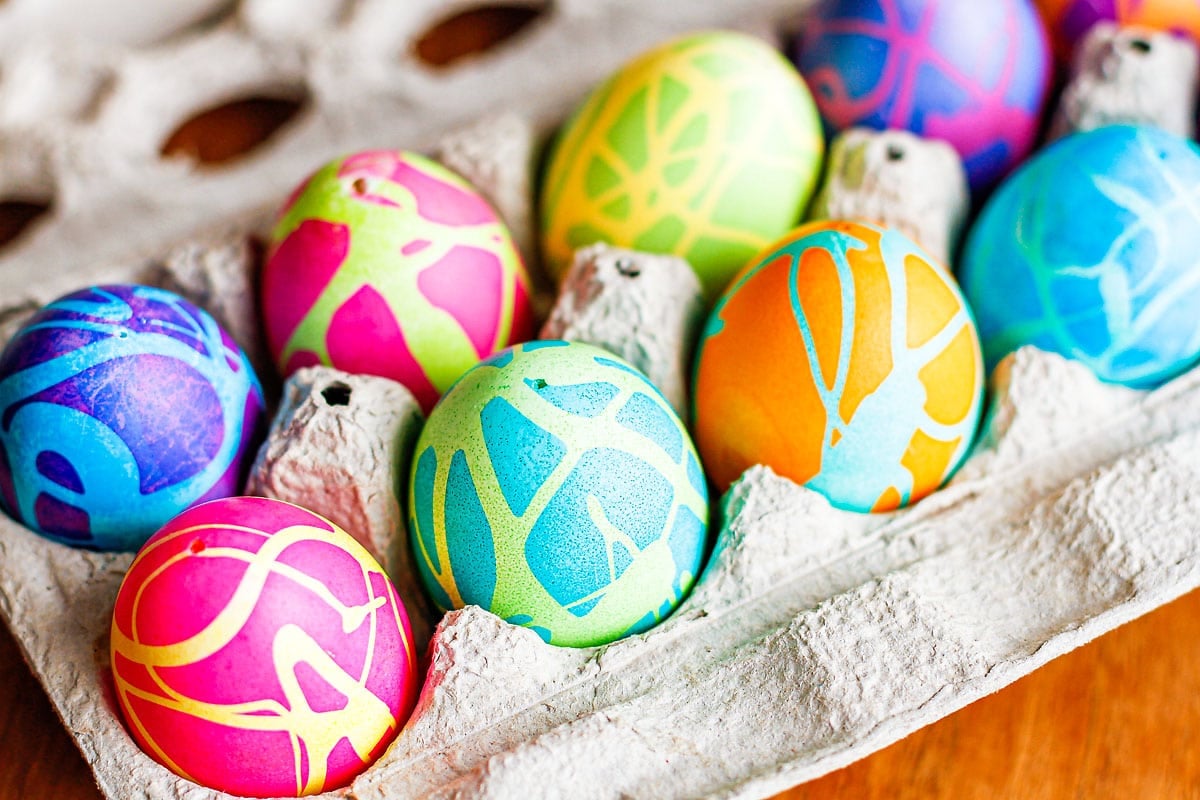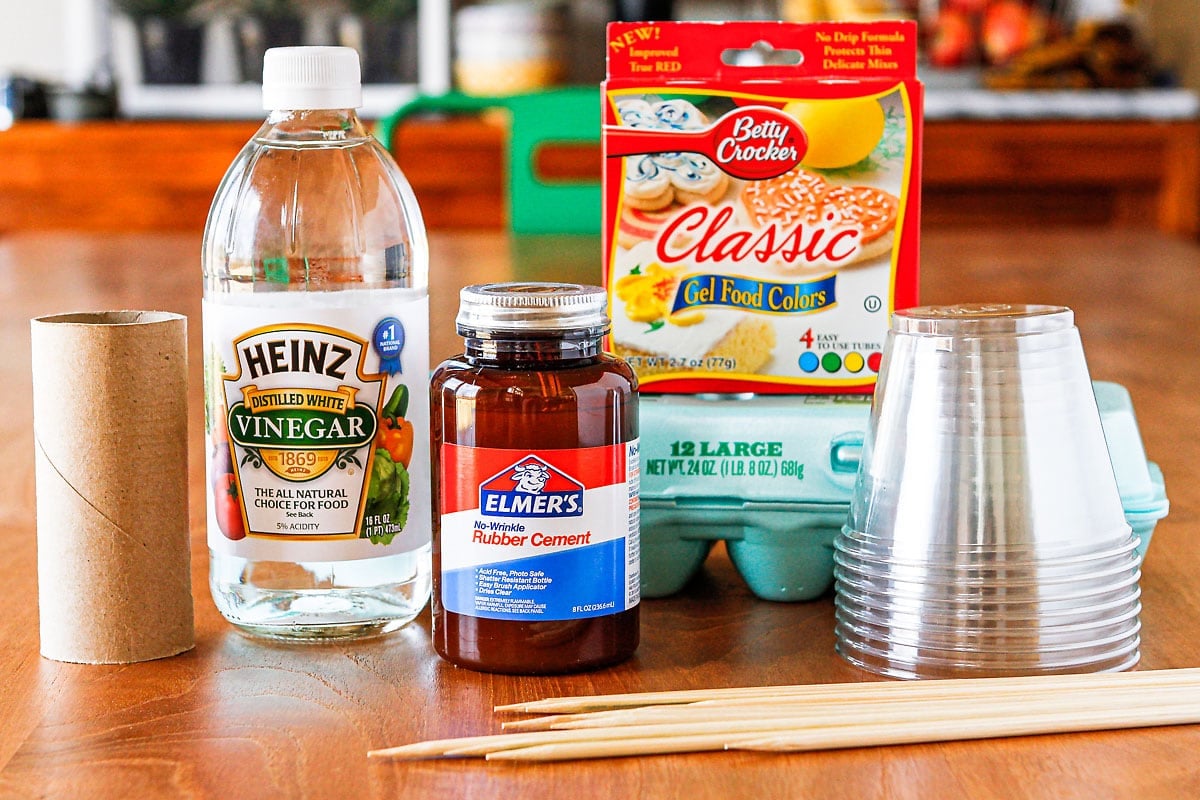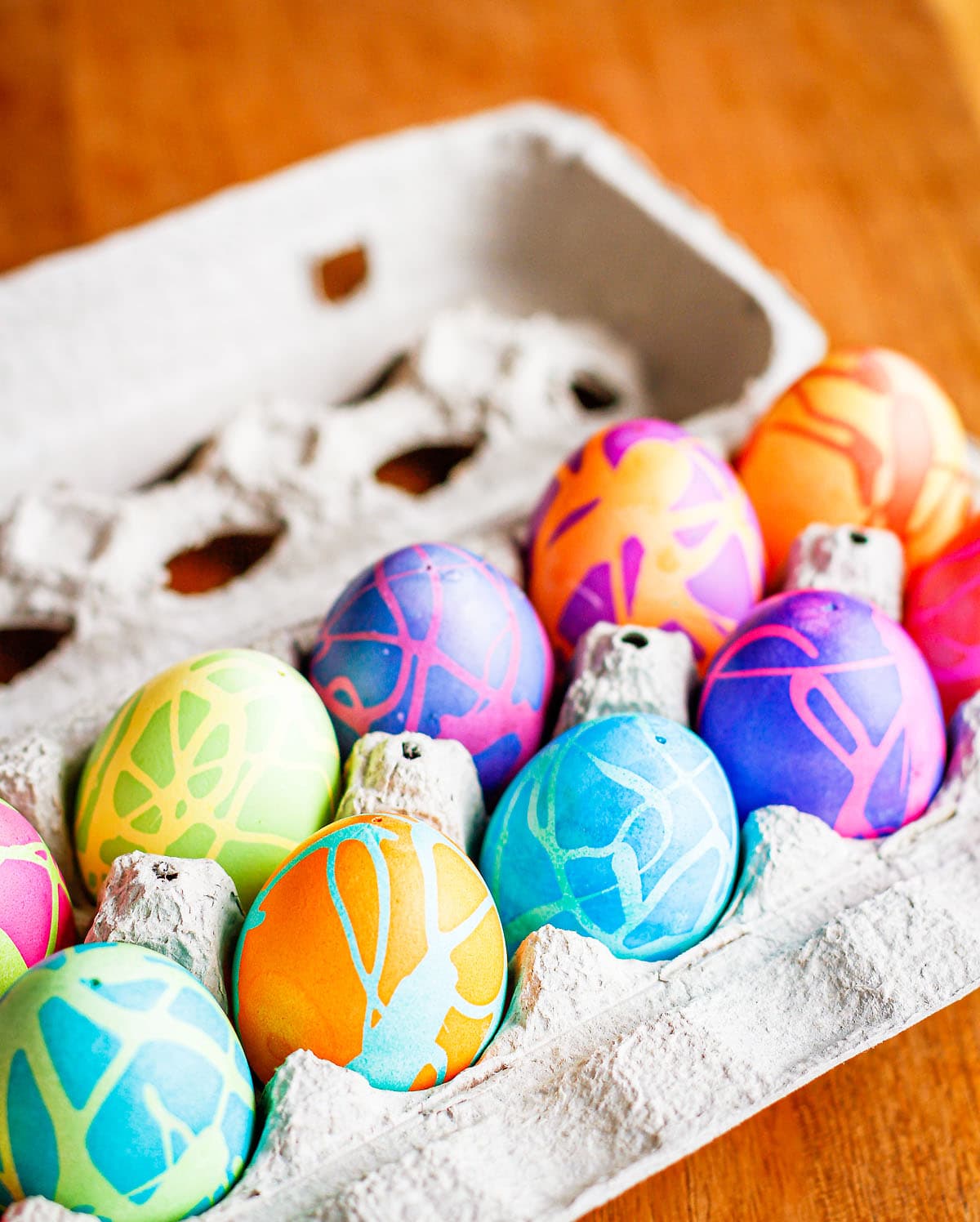Learn how to color Easter eggs with gel food coloring and rubber cement, a technique which produces some spectacularly high contrast & gorgeous abstract designs! Use it on blown-out eggs or dyeable plastic eggs to preserve these cool Easter eggs for years to come…

COLORING EASTER EGGS WITH RUBBER CEMENT
On the hunt for some new egg coloring ideas? I’ve got *JUST* what you’ve been searching for…
Coloring Easter eggs has always been one of my favorite Easter traditions, so I’m so excited to introduce you all to this beautiful rubber cement eggs technique… I mean, how amazing are these designs?!?
Coloring eggs with this process really could not be easier (kids can help!), and the brilliant contrasting colors are absolutely stunning!

SUPPLIES FOR MAKING DIY EASTER EGG DYE
When it comes to dyeing Easter eggs, I much prefer to make my own DIY Easter egg dye using Betty Crocker Classic Gel Food Colors over the tablet kits that you can purchase. The colors always turn out super vibrant, and you can easily control the shades with a little creative mixing.
- blown-out white eggs (or dyeable plastic eggs)
- Betty Crocker Classic Gel Food Colors*
- white vinegar
- rubber cement
- water
- plastic cups (to mix the dye in)
- paper towel or toilet paper tubes
- scotch tape
*Be sure to buy the 4-ct. Classic colors gel food coloring set. I tried the Neon colors set, and the ingredients differ slightly, which led to some funky residue that stuck to the eggs.
PRO TIP: While I don’t recommend using rubber cement on eggs you’re planning to eat, the DIY egg dye CAN be used alone and is food safe. If you’re going this route, my favorite method for boiling eggs for Easter is this Instant Pot hard boiled eggs technique.
However if you don’t own an electric pressure cooker, try this baked hard boiled eggs method. It was my go-to for years before I got my Instant Pot!

DIY EGG DRYING RACK
The first thing you’ll need to do is create an egg drying rack. I’ve seen a number of approaches that use foam and pins or nails to make stands, but this toilet paper tube rack idea I came up with is far less expensive and works just as well!
Simply cut a toilet paper or paper towel tube in half lengthwise. Then cut strips horizontally and tape the ends together to create a smaller circle that’s the perfect size for an egg to sit on. Hopefully you get the gist from the image above, but if you have questions, just ask!

HOW TO DYE EASTER EGGS WITH RUBBER CEMENT
As I mentioned, dyeing eggs with food coloring and this rubber cement technique is really simple and easy.
First things first, you’ll want to cover your work area to prevent stains. I also recommend setting both your dye cups and egg drying racks on rimmed baking sheets to help catch any accidental spills and/or drips.
Then just follow these steps for best results:
1| Using the water, vinegar, and gel food coloring, mix your desired dye shades according to the directions and color blending chart on the back of the Betty Crocker Classic Gel Food Colors package.
2| Start by dyeing your eggs a lighter base color. The actual color you select doesn’t matter so much as the length of time you leave the egg in the dye in this initial step. Check them frequently and remove while the intensity of color is still low. Drain off the dye and allow the egg to dry completely.

3| Once the eggs are dry, it’s time to apply the rubber cement. Holding an egg gently on either side, use the applicator brush to drizzle rubber cement over the egg in an abstract pattern. After a couple, you’ll get the hang of drizzling while avoiding your fingers. Allow the rubber cement to dry thoroughly.
4| Now it’s time to dye the eggs a second color. Choose a color that’s going to have high contrast with the base color, and leave the eggs in the dye until the color is very intense. Once you’re satisfied with the color, drain off the dye and allow the egg to dry completely again.
5| It’s time for the magic to happen! When your egg is thoroughly dry, simply use your fingers to gently rub the rubber cement off the eggs, revealing the lighter base color.
If you’ve used blown-out eggs, be *very* gentle when removing the rubber cement, especially near the holes on either end. I damaged a couple of my favorite patterns when I was a little too rough when rubbing it off.

MY FAVORITE COLOR COMBINATIONS
While I stuck with two dye colors for these images, you can get really creative with this method and make these Easter egg decorating ideas your own.
For example, you can pair three or more colors to create some pretty awesome effects. Just apply a little more rubber cement after each color application, and dye in successively darker colors.
I’d have to say my favorite combinations are the super high contrast colors, like the purple/orange and pink/yellow eggs. But I also think the more tonal blue/green and purple/blue eggs are pretty spectacular, too.
Get a little crazy and try different color combinations! If you’re not happy with the way one is turning out, you can just slip it into another color and dye over it until you’re satisfied.
NOTE: Several readers have questioned whether hard boiled eggs are safe to eat after using this technique. I’m going to err on the side of caution and say NO, I don’t recommend eating them. Rubber cement isn’t food safe, and eggshells are fairly porous — not a good combination.
However, the DIY gel food coloring egg dye by itself IS food safe. So you can safely use it on hard boiled eggs that will be consumed. If you’d like to dye hard boiled eggs that you plan to eat later on, I’d suggest using the egg dye for them first.
Then you can reuse the same dye with the rubber cement technique on hard cooked eggs that you DON’T plan to eat, blown-out eggs, or dyeable plastic eggs!